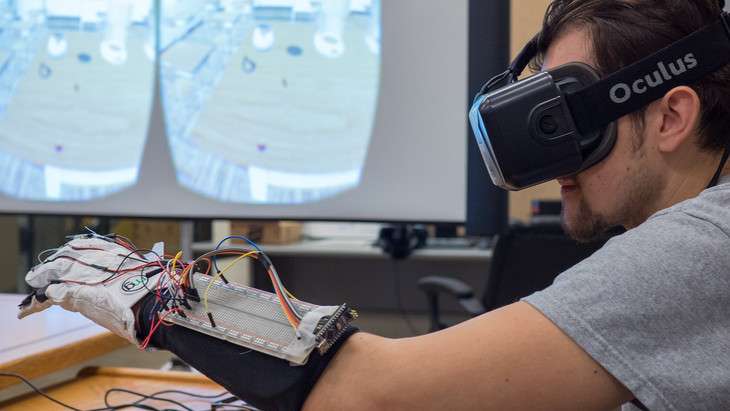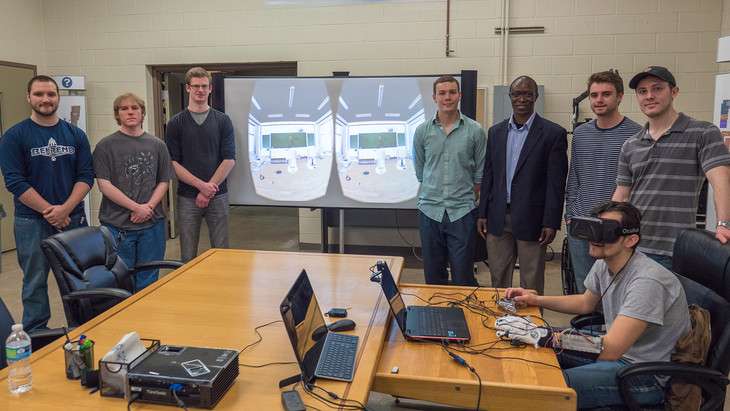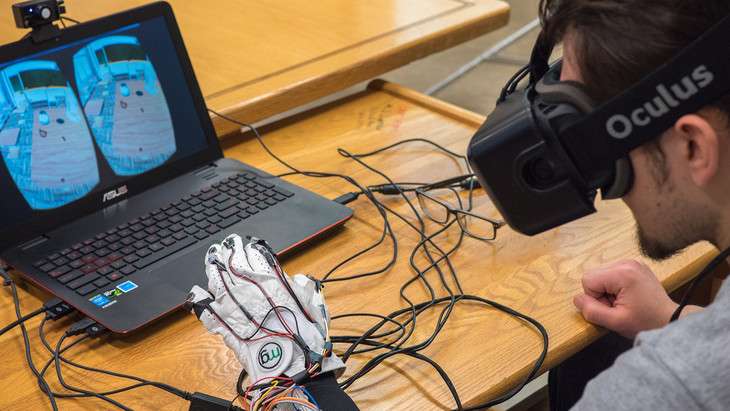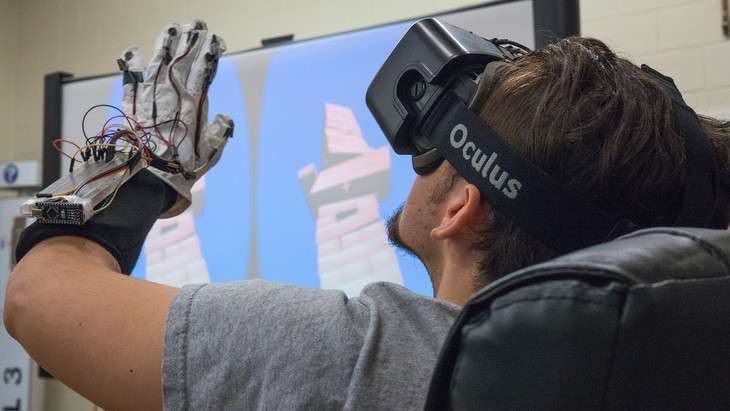Professor and students use oculus rift to improve online learning

Penn State engineering students have been working to develop an immersive virtual reality (IVR) system called Oculus Rift and test how this system and others may enhance student learning both on campus and online. The group hopes IVR technology can eventually give students taking online courses a way to become more engaged in their coursework.
Gathered in the Design Analysis Technology Advancement (DATA) Laboratory at Penn State University Park, the students joke, laugh and poke fun at each other as they prepare a demonstration of their virtual reality system. A nearby microwave sports a sign reading, "For Food Only," hinting at the type of mischief the room has seen.
But the students are definitely serious about their project, which is funded by a Center for Online Innovation in Learning (COIL) Research Initiation Grant (RIG) and supervised by Conrad Tucker, assistant professor of engineering design and industrial engineering.
"Online learning gives us huge opportunities in higher education. You can connect with more diverse people across greater distances, for example," said Tucker. "But online courses also limit you in some ways—there's little immersive or tactile interaction, and sometimes it's hard for students to engage with the material. IVR systems are a potential solution to that problem."
After the students finish setting up their demo, team member Owen Shartle straps the IVR headset over his eyes and slips on a haptic glove—a device that makes his hand look Transformer-esque but that allows him to interact with the demo's virtual world.
The headset transports him into an immersive, 3-D world. In today's demo, it's a traditional classroom with chairs, tables and a blackboard. The glove, still in its prototype phase, will enable him to pick up the pieces of a coffee maker scattered across the virtual table and assemble them in a much more natural way than using a joystick or keyboard controls.
With the exception of the IVR headset, everything was made by the students. The group designed the simulations—the coffee pot exercise, as well as a giant game of Jenga—with the software Unity3D. They also designed and built the haptic glove, which has gone through at least two versions, from scratch.
Bryan Dickens, a senior majoring in computer engineering, watches his classmate maneuver through the virtual world. He describes wearing and using the IVR device as similar to lucid dreaming.

"You know that you're not really in this new place, but in some ways you are," he said. "You can look around and see things that seem real. You're moving yourself through a different world, and that's what the virtual reality device is aiming for."
The technology isn't just cool, though. It's doing what Tucker hoped it would do: It helps students learn.
Tucker recently completed a study that found the device significantly improves a student's performance on a task when compared to doing the same activity in a non-immersive computer program, for example by playing the simulation on a flat screen and with traditional controls like a keyboard.
Tucker used the coffee pot simulation to compare how long it took 54 undergraduate engineering students to assemble the pot. The students were randomly split into two groups: One group completed the task using the IVR headset, and the other used a non-immersive computer program.
The median time it took the Oculus Rift group was 23.21 seconds, while the second group needed more than double that, clocking in at a median of 49.04 seconds. (The group's paper on this will be published in the upcoming ASME 2015 International Design Engineering Technical Conferences & Computers and Information in Engineering Conference.)
Tucker said there could be many reasons for the difference.
"Immersive virtual reality systems like the Oculus Rift have many benefits," he said. "One of the major ones is that when compared to the nonimmersive system, IVR systems give you a much more natural experience. It's like you're actually there."

Tucker said that in an online class, where a student may be isolated from the instructor and other students, this ability to be virtually immersed in another environment could be invaluable. Instead of just staring at a flat computer screen, students could be transported to a more traditional classroom environment or to another continent.
"Moving forward, we'd love to work with students in other countries," Tucker said. "Oculus Rift and other similar technologies allow you to sync your devices with others regardless of location and work on the same project. You can always Skype with people around the world, but you don't get the same experience. This technology would allow you to collaborate with others all over the world."
Tucker said students could even be teleported back in time just by strapping on their IVR headset .
Dickens, who graduated in May before moving on to a program manager position at Microsoft, said his research experience with Tucker was essential to his education and success.

"With research, you're building something that will last and be built upon," said Dickens. "If the world's knowledge of a subject is a circle, when you research with a cutting-edge technology like the Oculus Rift, you are working at the edge of the circle—pushing it further to expand its size. This kind of inventive work has helped my education more than any class could have."
And in Tucker's project, expanding that circle has also expanded Tucker's original expectations. He said that while he was always hopeful, he was also a bit skeptical going into the project. But after seeing how positively Dickens and the other students reacted to the technology, that has changed.
"When you see how student performance improves while using the device, it shows you how much potential it has to enhance online learning," said Tucker. "And now, Penn State has a real opportunity to be a leader in this space. It's very exciting."
Provided by Pennsylvania State University




















